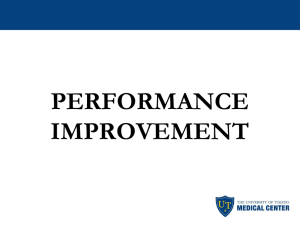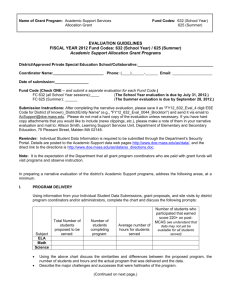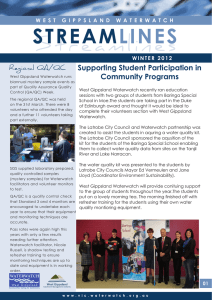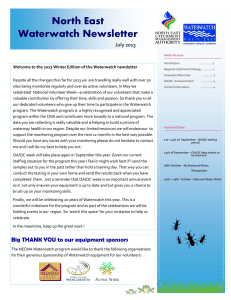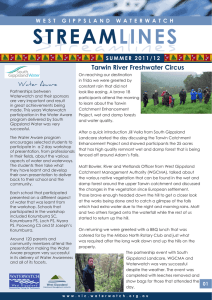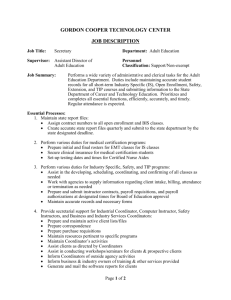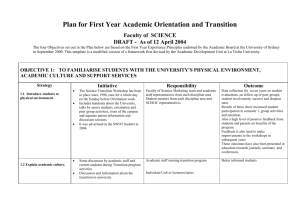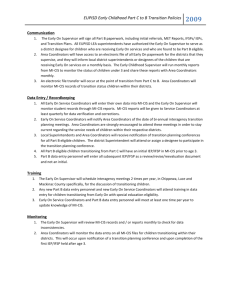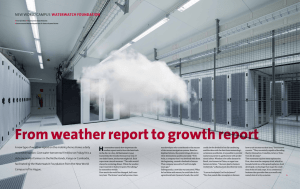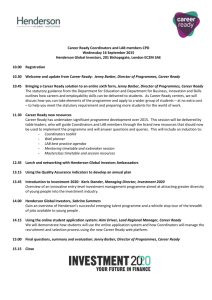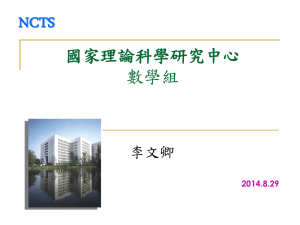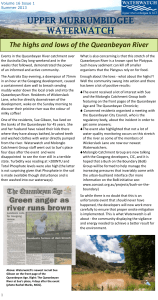10:00am Regional Wrap Up
advertisement
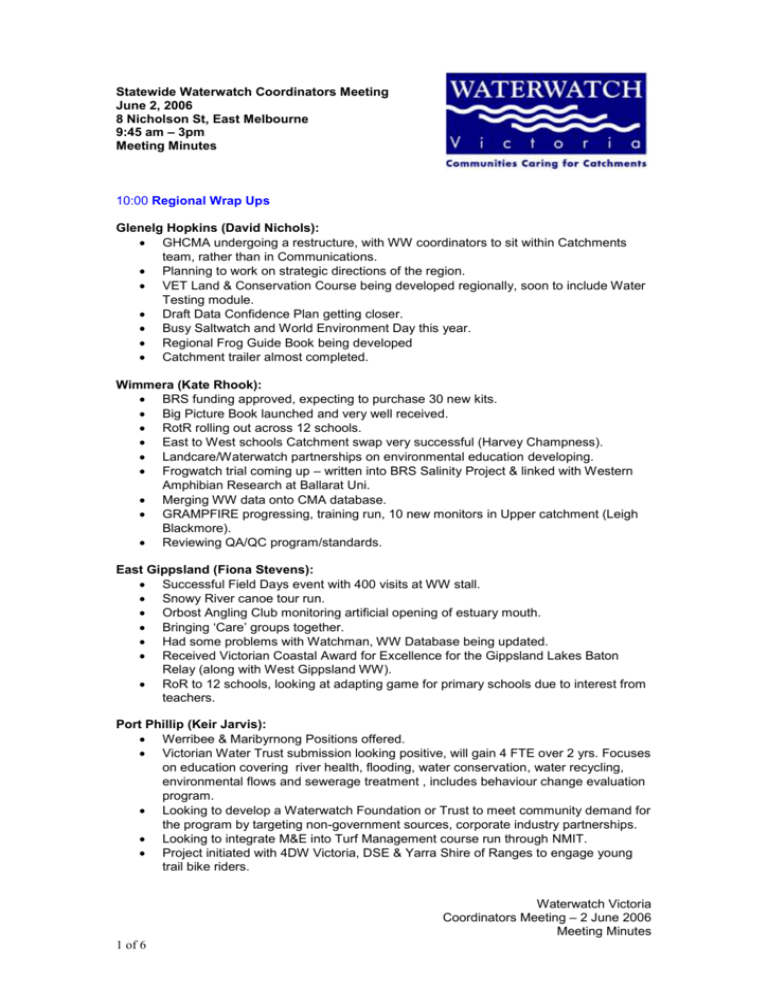
Statewide Waterwatch Coordinators Meeting June 2, 2006 8 Nicholson St, East Melbourne 9:45 am – 3pm Meeting Minutes 10:00 Regional Wrap Ups Glenelg Hopkins (David Nichols): GHCMA undergoing a restructure, with WW coordinators to sit within Catchments team, rather than in Communications. Planning to work on strategic directions of the region. VET Land & Conservation Course being developed regionally, soon to include Water Testing module. Draft Data Confidence Plan getting closer. Busy Saltwatch and World Environment Day this year. Regional Frog Guide Book being developed Catchment trailer almost completed. Wimmera (Kate Rhook): BRS funding approved, expecting to purchase 30 new kits. Big Picture Book launched and very well received. RotR rolling out across 12 schools. East to West schools Catchment swap very successful (Harvey Champness). Landcare/Waterwatch partnerships on environmental education developing. Frogwatch trial coming up – written into BRS Salinity Project & linked with Western Amphibian Research at Ballarat Uni. Merging WW data onto CMA database. GRAMPFIRE progressing, training run, 10 new monitors in Upper catchment (Leigh Blackmore). Reviewing QA/QC program/standards. East Gippsland (Fiona Stevens): Successful Field Days event with 400 visits at WW stall. Snowy River canoe tour run. Orbost Angling Club monitoring artificial opening of estuary mouth. Bringing ‘Care’ groups together. Had some problems with Watchman, WW Database being updated. Received Victorian Coastal Award for Excellence for the Gippsland Lakes Baton Relay (along with West Gippsland WW). RoR to 12 schools, looking at adapting game for primary schools due to interest from teachers. Port Phillip (Keir Jarvis): Werribee & Maribyrnong Positions offered. Victorian Water Trust submission looking positive, will gain 4 FTE over 2 yrs. Focuses on education covering river health, flooding, water conservation, water recycling, environmental flows and sewerage treatment , includes behaviour change evaluation program. Looking to develop a Waterwatch Foundation or Trust to meet community demand for the program by targeting non-government sources, corporate industry partnerships. Looking to integrate M&E into Turf Management course run through NMIT. Project initiated with 4DW Victoria, DSE & Yarra Shire of Ranges to engage young trail bike riders. Waterwatch Victoria Coordinators Meeting – 2 June 2006 Meeting Minutes 1 of 6 North Central (Melanie Barrot): River detectives now in 50 schools, signs have been developed for RD school fences. Danielle joined NC team BRS Project successful and will allow for an extra 1.8 FTE. Native/Exotic Fish Fact Sheets finished – Melanie is keen for photos, anyone? Frog Monitoring started. Regional River Health conference coming up. High participation in Saltwatch week. Involvement in the four Central Murray Environment Festivals, and opening of Pepper Green Farm (where WW activities will be run as part of the overall program). Central Highlands (Andrew Harris): Dung Beetle project up and running, looking at monitoring pre-post beetle application to measures effects on farm run off. Involved in Australian Schools Innovation in Science, Technology and Mathematics (ASISTM) Mentoring Program – high school students mentoring primary school students in WW monitoring. Running fungi workshop on request from community groups. Goulburn Broken (Michaela Bicknell): Very successful Saltwatch this year. Monitoring reports have been sent out to monitors on request and been well received, though require a lot of work to produce. Also interest from CMA/Goulburn-Murray Water in these reports, though there are caveats around data confidence levels. Catchment Capers website has had some work, almost fully operational. Running school holiday program in September. Some teachers/parents saw this as an opportunity for further education for interested students, not just fun holiday activities! Drainwatch update (Jim Galea) – produced new brochure and looking at new signs and approaches to attract more landholders to the program. Corangamite (Deirdre Murphy): Lots of work with schools and community groups. Conducting a survey of volunteers. Estuarywatch coordinator appointed – Kate Stapleton. Waterwatch nominated in CMA Catchment Awards (And won!) Hosted a field trip for Austrailan coastal researchers and managers at Anglesea, in conjunction with the Coast to Coast Conference in May. Macro cards with photography by Chris Walsh being finalised. Coordinators interested in ordering some please contact Anne McLaughlin. North East (Carolyn Humby): Toni Costello’s return from maternity leave has meant a team restructure. Bruce Birrell is leaving the program and Caz is staying on for another 12 months. Database is up-to-date. The Arbour Week activity (150 children) was funded through the Natural Resources Conservation League which is a great opportunity for regions to get money for community awareness activities. We received $2500 for the event PD day for the Water learn it Live Folder! was great success, good media attention RotR PD day has been cancelled due to lack of numbers from teachers, and will now be delivered individually to the schools in the area. This will take place in July Mallee (via email) The Mallee Environmental Schools Festival (with Mildura Regional Waste Management Group) huge success with over 511 students participate in Water Olympics, Cultural Heritage surveys, the workings of wetland birds, animals at night, Waterwatch Victoria Coordinators Meeting – 2 June 2006 Meeting Minutes 2 of 6 waste management and a tour of the local treatment plant. Evaluation forms were very positive and teachers were given a resource pack which outlined how they could use WW in their school curriculum. BRS Salinity project was successful, with money to develop an extensive salinity monitoring program across the region. It will also allow employment of an additional Waterwatch Officer, and purchase of additional equipment and resources. Mildura West Primary School will be travelling to the mouth of the Murray. They have completed water quality and macro invertebrate samples in Mildura which they will take with them to share and compare with the kids in South Australia. RotR - Had a bit of trouble implementing the run of the river board game due to time between registration and implementation. A lot of teachers have forgotten that they registered, teachers have moved on. Very slow process of re convincing teachers to get involved and lack of enthusiasm. Has anyone else had this issue? W. Gippsland (via email) Sponsor Luncheon and presentation of Recognition Certificates (this was very well received by sponsors who seem happier with us than ever). Hosted a Photopoint monitoring workshop for West & East Gippsland Waterwatch staff, volunteers and CMA representatives. Alison Pouliot came to the region to conduct the training. 36 people attend, with a good mix of volunteers and staff from different areas such as Landcare, operations, and waterway managers. Phil Marantelli's Frog Census program has been very, very popular! Haven’t done any advertising because word of mouth is more than enough. Action in Our Catchment Student Conference. Many schools worked on environmental projects with various organisations in the region (coordinated by Waterwatch) and then presented the findings of their projects at the conference. Undergone a review of how our Steering Committee functions. Next stage is to develop a Charter for the new year and beyond. Other Discussion Brand management of the WW Program was raised as a potential issue by Coordinators. A number of people/centres outside the Waterwatch Coordinators network were highlighted as running Waterwatch activities as part of a broader program, and incurring a fee (eg. Birdsland Environmental Education Centre, Peppermint Ridge Farm, adult volunteer who is part of the Science in Schools program). Some coordinators expressed concern that the Waterwatch name and services would loose their integrity and/or badging as a ‘free service’ in some communities. Waterwatch Victoria does not view this situation as a statewide problem at this stage, but one that produces opportunities and can be managed locally. The organisations/individuals identified were running and integrating a range of activities for the fee, not exclusively Waterwatch activities. Many Waterwatch resources are available free on the internet to anyone to run educational activities, and only ask that appropriate acknowledgment is paid if resources are used or reproduced. Regions could use this situation as a positive, by having their Regional Waterwatch program and its broader free services promoted by the facility to visitors. If time is spent building up to the capacity of staff/individuals to run educational activities, then your program could be viewing the number of people engaged at these centres as no different to teachers engaging many students in a school. These numbers could easily be included in M&E statistics (total number of participants – education/awareness). Please advise WW Vic if you think a bigger or reoccurring problem is emerging in your region. 11:00-11:30 Draft Central Sustainable Water Strategy Brett Spicer from the Water Resource Policy area in DSE gave a presentation on the content of the Draft Central SWS and what it means for Victoria in terms of future water supply/demand integration and community education around the issues. There are some major issues the strategy will raise, including: Waterwatch Victoria Coordinators Meeting – 2 June 2006 Meeting Minutes 3 of 6 The impacts of climate change on water supply; Addressing growing demand for water with rising population; How to balance consumptive demands with the need for increased environmental flows through water allocation systems; Major infrastructure work to create connectivity between supply systems for a more secure resource in water stressed areas such as Ballarat; Decisions on many of these issues will be based on the values we place on water. It will therefore be important for the community to be involved in these decisions, and community education is recognised as a key component to implementing the final strategy. WW could potentially be called on as a program to help CMA’s and water businesses to create water literate communities who can engaging in these important debate. There will be SWS’s prepared to cover all of Victoria, so all coordinators should keep a watching brief on what happens in this area of policy development. Brett’s Presentation is available on the Staff page of the website and if anyone has further questions or would like a copy of the Strategy, contact Yvette. 11:30 – 12:00 State Wrap Yvette 1. National Facilitator Don Thompson has been appointed as the National WW Facilitator. His work program is to be built on the National Needs and Gap Analysis of Community Engagement in Waterwatch (2004). There will be an opportunity for Victoria to provide input into a proposed work program through the National WW Forum in July. If any coordinators have any comments or idea on this, contact Yvette by the end of June. Merchandise New beanies & vests (mens and womens sizes!) are now available. There is also a new pricing/ordering system. Rather than member/non-member prices, there will now be coordinators/ public prices. To save admin time for MDC, only orders under regional coordinators name will be eligible for coordinators price. Tshirts will also soon be available, and if there is enough demand, long-sleeved volunteer’s shirts (white shirt with WW logo on front and “Waterwatch Volunteer” on the back). Coordinators interested in purchasing volunteer t-shirts, please provide numbers to Yvette asap so an order can be placed. 3. Database Ross Dunn is finishing his work on the WVA, which will then be handed to Collin Crawford (Sumo Software) to improve the user interface and make it as easy to use as possible! A training program, manual and a helpdesk are also planned for later on in the year when we are ready to roll out the new database. ODEA itself is ready to roll out, however because there will need to be training around how to set it up correctly for monitoring groups, it won’t be sent out until a database training program and the helpdesk are established. We like to request that all database enquiries come through state office, as being a helpdesk is not part of Ross’ brief and we want him to concentrate on finishing the WVA!! If there’s any major issue, we can then notify Ross. In terms of progress toward the Data Warehouse, all the QA/QC checks on WW data have been included in the mechanics of the WVA, so a transfer mechanism between the Warehouse and WVA is all that needs to be worked out. The DSE team are planning an overhaul of their database, and possibly appointing a new IT company to Waterwatch Victoria Coordinators Meeting – 2 June 2006 Meeting Minutes 4 of 6 look after it. They’ve advised us that as long as we have a database package which we are using and happy with, the transfer can be worked out. The latest version of the WVA will be sent out shortly, along with advice on the roll out of ODEA to monitoring groups. 4. Saltwatch Well done everyone on what sounds like a big Saltwatch for 2006. Apologies about the website issues, things seem to be running smoothly now. It was suggested a ‘What’s New’ link will be added to the WW website to the Snapshot website at appropriate times to generate more interest in the snapshots. The Saltwatch website remains open for posting data, but we recommend to encourage groups to have it posted by the end of the term – Friday 16th June. Also, data from previous years will also be available, contact state office if you would like to receive this. 5. Run of the River A Cheatsheet is available to help you think about the key aspects of the game and the messages teachers should be taking away from the session. The Cheatsheet was designed for coordinators, and may not be useful for teachers in running the game in the classroom, as it concentrates on the mechanics of what is happening during game play and how to pull out the learning experiences, not so much the messages themselves. Teachers may find it helps to plan their sessions, if they express an interest pass it on. We have to stress that the Cheatsheet is not a substitute for pd session! Also, evaluation material is on the website so please remind your teachers that we’d appreciate any feedback they have, and don’t forget there are the digital cameras as incentives! 6. Catchment Capers Website David Hodgkins has got a figure for any region wishing to adapt GB’s Catchment Capers website to their own schools program – looking like about $2.5K to transfer the platform to another regions ‘look and feel’ Any one interested, speak to Michaela and she can put you in contact with the IT people responsible. 7. WW Website – BRS Project Section Leigh Mitchell is interested in getting together with other regions with BRS Salinity Projects to create a section and the WW website devoted to these projects. Any one interested in forming a working group, contact Leigh. 8. Regional Coordinator meetings Yvette is keen to get out to the regional meetings to get an understanding of how each regional operates/regionally specific issues/meet all coordinators. When these meetings are scheduled, please let her know so she can come along! Sara 9. Online Macroinvertebrate Resources WW Vic is working with John Hawking’s team to build some prototype online educational resources, as part of the Online Colour Web Guide. Feedback has been sought and received from several local coordinators to test where the needs lie. We will be working with one region to develop the prototypes, before expanding across the state. 10. Corangamite Waterwatch’s Macroinvertebrate Cards Waterwatch Victoria Coordinators Meeting – 2 June 2006 Meeting Minutes 5 of 6 The approximate cost for 100 copies of the ‘Now and Then’ macroinvertebrate flip cards (50 cards on 20 types of macroinvertebrates, larval and adult cards, same format as WeedDeck) will be ~$2000, if we have orders for more than 500 copies statewide. Please contact Sara or Anne McLaughlin for more information. 11. Purchasing macroinvertebrate equipment There was interest at Sale’s training course for Sara to coordinate a bulk purchase of macroinvertebrate equipment from different suppliers. Some options and costing are provided in the attached list. Coordinators are encouraged to contact Sara is there is a need for these specialist items in your region. 12. Coastal Research Symposium, May 30 2006 Sara attended this national research Symposium (as did Tanya Cowell from WG) on coasts and estuaries. Happy to photocopy abstracts if coordinators would like to know more. Sara discussed two opportunities at the coordinators meeting – A – Helen Arundal from Deakin University is developing the Estuary Entrance Management Support System for managers to decide whether an estuary mouth needs to be opened artificially. This support system should encourage dialogue and a transparent process with communities and stakeholders. Helen is trailing the framework with 2 estuary communities in each of the Corangamite and Glenelg Hopkins regions. There are big opportunities for communities to be involved in the monitoring of 6 indicators (water level, duration of inundation, time of year, period since last opened, flow and DO) in the decision support framework. Sara strongly encouraged WW coordinators in each of these regions to be aware of upcoming opportunities, and attend one of the workshops in your region. B – A new free feature of OzCoast website (www.coastal.crc.org.au/ozcoast/index.html) is the ability to build and print your own coastal conceptual diagrams for your own estuary. Models are based on different estuary classifications, but some great icons to help build images of what’s impacting YOUR estuary. Could be a good ICT opportunity for high school students? 13. Yearbook 2005 Has been signed off by the minister, and should be printed within the month. 14. Research Student We have a 4th Year NRM student from Melbourne University undertaking a research project for us on multicultural values of water. It is based on the UN’s World Water Day work that looked at the role of water in different cultures, mythology and religion. We hope to be able to use this research to support a new resource sometime in the future, so will be awaiting her research outcomes with interest. 15. Free resources for Coordinators – Regional Matters – am Atlas of Regional Victoria 2005. More copies are available for sale for $30 from DSE bookshop. Waterwatch Australia Technical Manual Module 6 – Groundwater Monitoring. Spare copies of this resource are available from WW Vic. ISC2 User Manual (2nd Ed) – This manual has been developed to assist those collecting field data for the streamside zone and physical form sub indices. Don’t forget copies of the Central Sustainable Water Strategy from Yvette too. 12:00–12:30 Partnership Project Experiences Andrew Harris presented his paper from the AWA Water Educators Conference from earlier in the year, highlighting some of the collaborative projects Central Highlands WW have been up Waterwatch Victoria Coordinators Meeting – 2 June 2006 Meeting Minutes 6 of 6 to. Andrew noted an effective tactic for getting sponsorship is to pitch a specific project/initiative with links to the target sponsors’ own activities/objectives. 12:30-13:00 Lunch 13:00-14:00 State QA/QC Developments See information on Staff page Science Support -> QA/QC Week 2006 for all supporting information and resources for QA/QC Week. 14:00 Other Business/Show and Tell discussion of new Equipment Waterwatch Victoria Coordinators Meeting – 2 June 2006 Meeting Minutes 7 of 6
